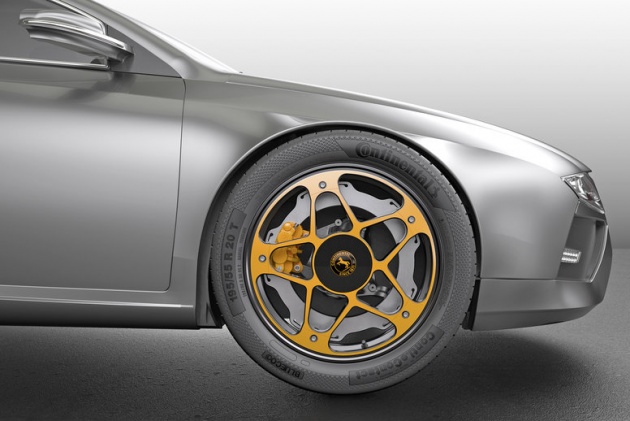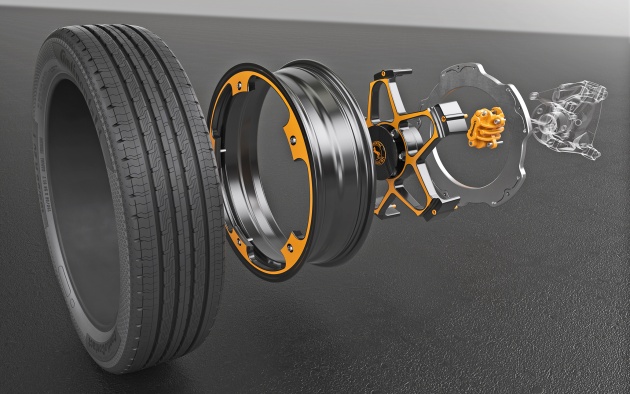Automotive components maker Continental is bringing a strong focus on electric vehicles to the 2017 Frankfurt Motor Show next month – in addition to its inductive wireless charging technology, it is also going to showcase a new integrated wheel and brake concept to rethink the way EVs move and stop.
Why the need to literally reinvent the wheel? Because electric vehicles are able to utilise regenerative braking to decelerate – recouping the kinetic energy usually lost through mechanical braking – so a physical disc brake system is used less frequently.
As such, a typical cast iron brake disc could rust, impairing braking performance when it is actually needed, such as under hard braking, or for features such as torque vectoring by braking or autonomous emergency braking. To solve this, Continental has created an aluminium brake disc that resists corrosion.
The design of the disc is also unique – it is annular and fastened to the star-shaped wheel spoke and hub assembly, which in turn is bolted to the wheel rim; the brake calliper, meanwhile, is upside down and clamps onto the inner edge of the disc. This design permits a larger disc diameter that improves braking performance, and is also said to make brake pad changes easier.
The use of aluminium brake discs also makes the whole wheel and brake assembly lighter; it has a side effect of being a very good heat conductor, allowing heat generated under braking to quickly dissipate. Continental also claims that the discs do not wear out, with abrasion only happening on the pads – so you’ll only ever have to swap out the latter.
“Because the brake disk is fixed on the outside and the brake engages from the inside, the brake caliper can be designed particularly light and stiff. The force is transmitted largely symmetrically into the center of the axle, and this has a favorable effect on the noise behavior of the brake,” said Continental brake pre-development boss Paul Linhoff.
Looking to sell your car? Sell it with Carro.




Malaysia national car companies don’t have to worry about this cause it is the only 2 car companies in the world without EV, PHEV or Hybrid.
All tido
And in what way did you contribute to make things better?
By bashing 24/7. Oh wait, that only contributes to his own pocket
How about both of you?
I only contribute to the betterment of humanity. Specifically ASEAN lives.
and getting everything free and asking for discounts
Hmm. Looks like watch tourbillon
This i really dont get. Seems overly complicated.
Why don’t they just use inboard brakes like they used to?? Has no weight penalty to unsprung weight. And with the use of aluminium, there is less issues with cooling which where a problen with early inboard brakes not getting enough air.
I guess you’re talking about the “old” designs, where the discs were mounted inside directly at the gearbox (for example Jaguar E-Type)? From the technical point of view, this design was superior to what they do today (less unsprung masses).
But they moved away from that design for a good reason: Accessibility. In the good old days the drive shafts and other parts had to be removed to change the brakes. That’s too expensive nowadays, nobody would pay the triple price (or even more) for changing the brakes.
Good point. Recalling my old Alfasud.
Its because of packaging, especially transversely mounted engines and big disks.
Well, this is not our father’s inboard brakes.
Considering the proposal is aimed at EV, packaging would be less of an issue then when running ICE.
Now electric motors can be much more compact (and even have 1 motor per wheel) so just by directly mounting the braking system on the motor itself isn’t as daunting as before. It has the added benefit of directly transferring the braking loads to the chassis instead of the suspension components.
Yes, maintenance costs will be higher, but then again, a EV will have regenerative braking so thus, it is safe to say, there will be less load and wear on the brakes increasing longevity and service life to minimize replacement. Given that there has been a great strides in material engineering, I would think replacing brake pads is such an issue anymore as when compared to the “old times”. How long does our brakes last nowadays? 100k km?
the idea is not new. Michelin has a similar concept called tweel which combines wheel and tyre more than 5 years ago. but this one is a level above.
brilliant.
I agree that it seems too complicated and unnecessary, but it is only a concept, the final design will be simpler, probably.
In-board brakes didn’t pick up because they were complicated and expensive. They take up space in the middle of the vehicle, relatively difficult to change and like you mentioned, cooling is a problem as well.
Unsprung weight made a difference for ICE cars, but for EVs where the batteries are flat and mounted low-middle, Conto’s concept makes more sense to increase the braking and regen efficiency for the wheels, as well as allowing more space for suspension systems.
Please do look up a few post for the same reply. I think we are still thinking about our “father’s” old inboard brakes here.
The packaging for EVs will be very different and effective.
Since the disc is now attached to the rims, won’t it heat up the wheel and tyre air pressure will go up more….
If an EV uses in wheel motor in all 4 wheels, you don’t event need physical brakes. The brake force those motors produce are far more than needed and there will be no issues with brake cooling. Only the drive motor control unit needs cooling which it already has.